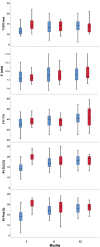Impact of bridging with left ventricular assist device on right ventricular function following heart transplantation
- PMID: 35322594
- PMCID: PMC9065852
- DOI: 10.1002/ehf2.13890
Impact of bridging with left ventricular assist device on right ventricular function following heart transplantation
Abstract
Aims: Patients awaiting orthotopic heart transplantation (OHT) can be bridged utilizing a left ventricular assist device (LVAD) that reduces left ventricular filling pressures, decreases pulmonary artery wedge pressure, and maintains adequate cardiac output. This study set out to examine the poorly investigated area of if and how pre-treatment with LVAD impacts right ventricular (RV) function following OHT.
Methods and results: We prospectively evaluated 59 (LVAD n = 20) consecutive OHT patients. Transthoracic echocardiography (TTE) was performed in conjunction with right heart catheterization (RHC) at 1, 6, and 12 months after OHT. RV function TTE-parameters included tricuspid annular plane systolic excursion (TAPSE), systolic tissue velocity (S'), fractional area change, two-dimensional RV global longitudinal strain and longitudinal strain from the RV lateral wall (RVfree). At 1 month after OHT, the LVAD group had significantly better longitudinal RV function than the non-LVAD group: TAPSE (15 ± 3 mm vs. 12 ± 2 mm, P < 0.001), RV global longitudinal strain (-19.8 ± 2.1% vs. -14.3 ± 2.8%, P < 0.001), and RVfree (-19.8 ± 2.3% vs. -14.1 ± 2.9%, P < 0.001). At this time point, pulmonary vascular resistance (PVR) was also lower [1.2 ± 0.4 Wood Units (WU) vs. 1.6 ± 0.6 WU, P < 0.05] in the LVAD group compared with the non-LVAD group. At 6 and 12 months, no difference was detected in any of the TTE and RHC measured parameters between the two groups. Between 1 and 12 months, all parameters of RV function improved significantly in the non-LVAD group but remained unaltered in the LVAD group.
Conclusions: Our results indicate that pre-treatment with LVAD decreases PVR and is associated with significantly better RV function early following OHT. During the first year following transplantation, RV function progressively improved in the non-LVAD group such that at 6 and 12 months, no difference in RV function was detected between the groups.
Keywords: Early follow up; Heart transplantation; Left ventricular assist device; Right heart catheterization; Strain; Two-dimensional echocardiography.
© 2022 The Authors. ESC Heart Failure published by John Wiley & Sons Ltd on behalf of European Society of Cardiology.
Conflict of interest statement
All authors have no conflicts of interest to declare.
Figures

References
-
- Najjar E, Lund LH, Hage C, Nagy AI, Johnson J, Manouras A. The differential impact of the left atrial pressure components on pulmonary arterial compliance‐resistance relationship in heart failure. J Card Fail 2021; 27: 277–285. - PubMed
-
- Nauser TD, Stites SW. Pulmonary hypertension: new perspectives. Congest Heart Fail 2003; 9: 155–162. - PubMed
-
- Stobierska‐Dzierzek B, Awad H, Michler RE. The evolving management of acute right‐sided heart failure in cardiac transplant recipients. J Am Coll Cardiol 2001; 38: 923–931. - PubMed
-
- Lundgren J, Soderlund C, Radegran G. Impact of postoperative pulmonary hypertension on outcome after heart transplantation. Scandinavian cardiovascular journal: SCJ 2017; 51: 172–181. - PubMed
-
- Lundgren J, Algotsson L, Kornhall B, Radegran G. Preoperative pulmonary hypertension and its impact on survival after heart transplantation. Scandinavian cardiovascular journal: SCJ. 2014; 48: 47–58. - PubMed
Publication types
MeSH terms
LinkOut - more resources
Full Text Sources
Medical
Research Materials

